
Saxifraga is the largest genus in the family Saxifragaceae, containing about 440 species of holarctic perennial plants, known as saxifrages or rockfoils. The Latin word saxifraga means literally "stone-breaker", from Latin saxum + frangere. It is usually thought to indicate a medicinal use for treatment of urinary calculi, rather than breaking rocks apart.

Saxifraga flagellaris, the whiplash saxifrage, is a plant native all over the high arctic and some areas of northern Rocky Mountains, and Norway. It is not very common. It is also known as spider saxifrage or "spider plant", though the latter name more commonly refers to the unrelated Chlorophytum comosum (Agavaceae).

Saxifraga oppositifolia, the purple saxifrage or purple mountain saxifrage, is a species of plant that is very common in the high Arctic and also some high mountainous areas further south, including northern Britain, the Alps and the Rocky Mountains.

Saxifraga cespitosa, the tufted alpine saxifrage or tufted saxifrage, is a flower common to many arctic heights. It appears further south in mountainous areas of the Alps, Norway, Scotland, Wales, Iceland, Siberia, western North America and Greenland.

Pimpinella saxifraga, known as burnet-saxifrage, solidstem burnet saxifrage, lesser burnet is a plant species in the family Apiaceae, a native of the British Isles and temperate Europe and Western Asia. It is neither a burnet, which its leaves resemble, nor a saxifrage although it has a similar herbal effect as a diuretic.
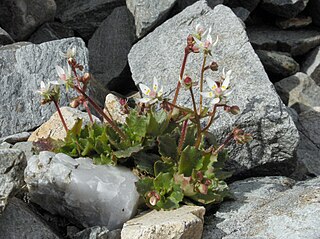
Saxifraga stellaris, the starry saxifrage or hairy kidney-wort, is an Arctic–alpine species of saxifrage. It produces panicles of 5–10 white flowers on a stem up to 20 cm (7.9 in) tall, rising from a basal leaf rosette. One subspecies is found from eastern Canada to Russia, including the British Isles, while another is found in the mountains of southern Europe.

Saxifraga paniculata is an alpine species of flowering plant in the saxifrage family, with native distribution in the temperate northern hemisphere. Common names include alpine saxifrage, encrusted saxifrage, lifelong saxifrage, lime-encrusted saxifrage, livelong saxifrage, White Mountain saxifrage, and silver saxifrage.
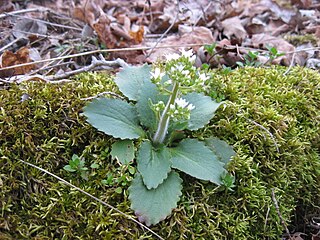
Micranthes virginiensis, the early saxifrage, or Virginia saxifrage, is a wildflower native to eastern and central North America. It is a herbaceous plant, which can reach 30 cm (12 in) tall.

Saxifraga aizoides, yellow mountain saxifrage or yellow saxifrage, is a flowering herb and alpine plant of the genus Saxifraga.

Saxifraga cotyledon, the pyramidal saxifrage, occurs in the mountains of Europe and has rosettes about 20 centimetres (8 in) across of tongue-shaped leaves, beaded but not toothed. In May or June the tall panicles of white flowers, branched and pyramidal in outline, may reach 60 cm (24 in). It is one of Norway's two national flowers. Its relationship to the "silver saxifrages" remains to be resolved to full satisfaction.
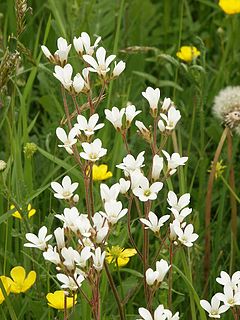
Saxifraga granulata, commonly called meadow saxifrage, is a species of flowering plant of the genus Saxifraga in the family Saxifragaceae.
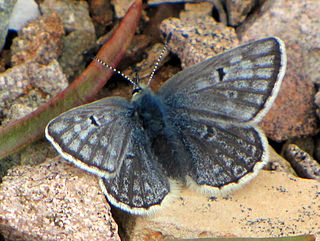
Agriades glandon, the Arctic blue or Glandon blue, is a species of butterfly in the family Lycaenidae. It in found in Eurasia and North America.
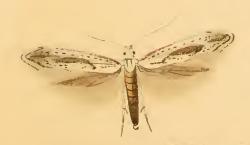
Kessleria saxifragae is a moth of the family Yponomeutidae. It is widespread in Europe and is also recorded from the Levant.

Saxifraga rivularis is a species of saxifrage known by several common names, including highland saxifrage, weak saxifrage, alpine brook saxifrage, and pygmy saxifrage.
Stenoptilia pelidnodactyla is a moth of the family Pterophoridae. It is found in most of Europe, except Portugal, Great Britain, Ireland, the Netherlands, Croatia, Greece, Lithuania and Ukraine.

Saxifraga aspera is a species of saxifrage known by the common name of rough saxifrage. In German it is known as Rauhhaariger Steinbrech. It is placed in section Trachyphyllum of the genus Saxifraga. There are two subspecies, Saxifraga aspera subsp. aspera and Saxifraga aspera subsp. micrantha. It is a plant of the pan-Arctic tundra and is also found in Europe at moderately high altitudes in the Alps, Pyrenees and northern Apennines.
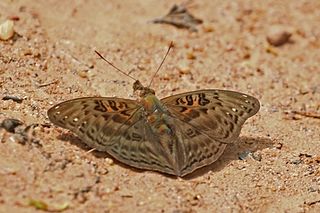
Euryphura chalcis, the common commander, is a butterfly in the family Nymphalidae. It is found in Senegal, Guinea, Sierra Leone, Liberia, Ivory Coast, Ghana, Togo, Benin, Nigeria, Cameroon, Gabon, the Republic of the Congo, the Central African Republic, the Democratic Republic of the Congo, Uganda, Kenya, Tanzania and Zambia. The habitat consists of forests.
Meza indusiata, the snowy missile, is a butterfly in the family Hesperiidae. It is found in Senegal, Guinea-Bissau, Sierra Leone, Liberia, Ivory Coast, Ghana, Nigeria, Cameroon, Gabon, the Republic of the Congo, Angola, the Democratic Republic of the Congo and Uganda. The habitat consists of forests.

Petrorhagia saxifraga, known as tunic flower or coat flower, is a small, herbaceous flowering plant in the family Caryophyllaceae. It is native to parts of Europe and introduced to the United States and Canada, Great Britain, and Sweden. Petrorhagia saxifraga is also known as tunic saxifrage, pink saxifrage, or just pink.
















